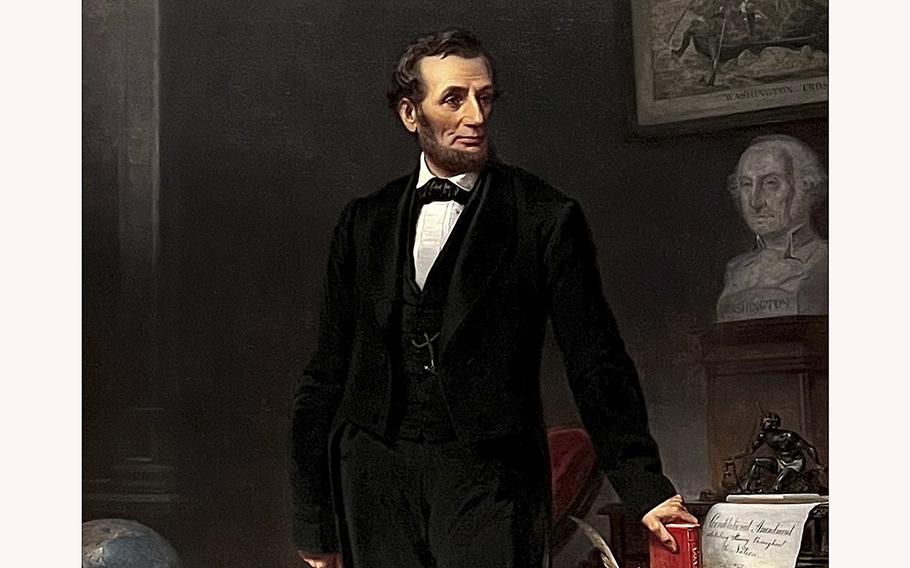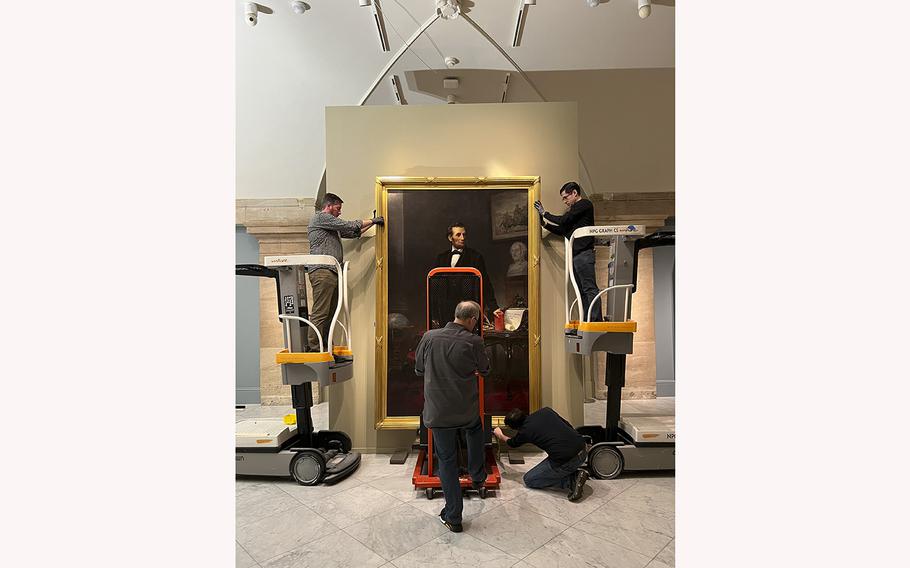
A close-up of an 1865 portrait of Abraham Lincoln by W.F.K. Travers is on display at the National Portrait Gallery. (Smithsonian’s National Portrait Gallery)
The National Portrait Gallery unveiled a rare portrait of President Abraham Lincoln on Friday, ahead of Lincoln's 214th birthday. The nine-foot-tall portrait, painted by W.F.K. Travers in 1865, is one of only three known full-length renderings of the 16th president and will be on loan to the Smithsonian gallery in downtown D.C. for the next five years.
The painting, which hung for decades in relative obscurity in a municipal building in a small New Jersey town, has been newly restored and is now part of the "America's Presidents" gallery.
There are plenty of photographs of Lincoln, but, like most subjects of the day, he sits stiffly and somberly, and of course, is rendered in black and white. This portrait - painted in color, face relaxed with a hint of a smile, and body standing at its full 6-foot-4 height - offers viewers perhaps the best opportunity today to see Lincoln as he really was.
At least, that's what his friends thought. Ward H. Lamon, a close friend and bodyguard, wrote in 1888 that the painting was "the most lifelike picture of Mr. Lincoln I have ever seen on canvas."
It "presents a real likeness of the man, with his rugged features and irregularities of personal appearance, true to life," he wrote. Even if Lincoln's face were covered, friends would recognize him immediately just by "the trunk and limbs."
Little is known of the artist, W.F.K. Travers - even his full name is unclear, with different sources calling him George W.F. Travis, W.R. Travers, W.F. Travers and William F.K. Travers. He was once thought to have been German, but recent scholarship suggests he was Dutch and lived all over the world, including Germany, according to Lincoln biographer Ted Widmer. Travers came to the United States in 1862, though a long-repeated story that he tried to join the Union Army but was rejected for a medical condition has not been substantiated.
What is known is that Lincoln sat for Travers in 1864, and that Travers completed the oil painting in Germany shortly after Lincoln's assassination in April 1865. He soon sold it to an American diplomat living in Frankfurt.
In 1876, the painting popped up at an exposition in Philadelphia, where, as one legend goes, Mary Lincoln "was so overcome by its lifelike appearance that she fainted and was carried out of the hall."

Staff at the Smithsonian’s National Portrait Gallery install an 1865 portrait of Abraham Lincoln by W.F.K. Travers. The painting is on loan to the gallery for five years from the Hartley Dodge Foundation. (Smithsonian’s National Portrait Gallery)
For years, it hung in the U.S. Capitol while Congress debated whether to purchase the canvas, until it was finally sold to the Rockefeller family. In the 1930s, Geraldine Rockefeller Dodge - daughter of William Jr. and niece of John D. - built a lavish hall in Madison, N.J., where she lived, which she called the Hartley Dodge Memorial Building in memory of her deceased son. She filled the hall with art, including the Lincoln portrait, and then donated it to the town in 1935. The Hartley Dodge Foundation maintains the building and its art to this day.
For decades, Widmer wrote last year, the painting was "hiding in plain sight where it was seen by very few Americans outside the townspeople who filed past it on their way to pay parking tickets and water bills."
In 2017, a part-time archivist discovered that a marble bust of Napoleon sitting in the corner of the borough council room had been sculpted by Auguste Rodin, prompting the foundation to reassess all of the art in its collection. The loan of the Lincoln portrait to the National Portrait Gallery is part of that reassessment.
In addition to Lincoln's likeness, the painting is filled with symbols noting the president's place in history. He stands in front of a bust of George Washington and a rendering of the painting "Washington Crossing the Delaware" by Emanuel Leutze, one of the most famous images in the world in the mid-1800s. Lincoln's hand rests on a bound copy of the Constitution, next to a scroll bearing a draft of the 13th Amendment. Behind the scroll is a small statue of an African American man rising as he pulls the chains from his body.
The painting was unveiled at a ribbon-cutting Friday morning and is now open to the general public. On Saturday, Feb. 18, it will be featured in the gallery's "Presidential Family Fun Day," along with life-size 3D models of Lincoln's hands and face, which visitors are welcome to touch.